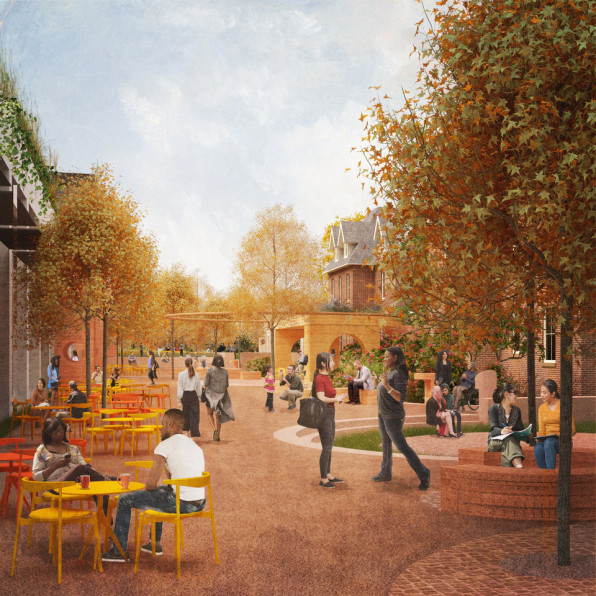Richard Dougherty grew up in a home with a rectangular dining table, pocket-sizing windows, and small rooms. Developed additional than 200 a long time ago, the Georgian-fashion residence in Eire had once been used as a church rectory. It was dark, damp, and chilly, which “made it particularly hard for me, as someone who relies upon on distinct eye call, lip-reading through, and other facial expressions for conversation,” he claims. The shut-off rooms didn’t assist both “[because they] minimal my visible access and cues.”
Dougherty is deaf his mother and father and 4 siblings are not.
Dougherty is the guide architect on what is envisioned to be the very first community house in the U.S. designed applying DeafSpace layout and architecture. The style philosophy, produced in 2006 as the DeafSpace Structure Project, involves a lot more than 150 architectural things that consider into account “the distinctive way the deaf individuals relate to their physical ecosystem,” suggests Dougherty, such as house and proximity, sensory achieve, mobility and proximity, and gentle and coloration and acoustics.
The new area, which features an outdoor location dubbed Creativity Way, is on the campus of Gallaudet University, the only 4-calendar year liberal arts establishment in the region for the deaf and tricky of hearing. Chartered by President Lincoln in 1864, Gallaudet, the place DeafSpace style and design was produced, is also incorporating 3 new buildings that will employ DeafSpace principles and open up up the campus to the D.C. community all around it.
***
Even though Dougherty grew up in a hearing family, his wife, Sarah, was elevated in a property that, “encapsulates all the things about the ‘deaf world’—a prosperous sensory earth full of silent conversations, visible animation, and a specific cultural identification,” suggests Dougherty. Sarah, her siblings, and their mom and dad are all deaf. “The dwelling was an oasis of spatial delight for me,” says Dougherty, recalling the first time he visited. “[There was] an abundance of normal lights, tactile and heat surfaces, crystal clear obtain to the gardens. The smells ended up distinctive, also.”
His in-legal guidelines, he claims, spent decades redesigning their 1930s household to “suit the family’s exclusive ‘ways of being,’” which included removing partitions and adding strategically put lights and mirrors. Reflective surfaces can aid visual interaction and enable a deaf particular person see that a person is powering them. The distinctions amongst Dougherty’s childhood household and his wife’s served him “appreciate the values and power of the fundamental connections concerning deaf individuals and the spaces they inhabit.”
That paved the way for Dougherty to turn out to be the lead architect on GU’s pedestrian-centered general public space, as very well as GU’s advisor on the 3 new properties. These will attribute 30,000 square feet of floor-ground retail area and 15,000 sq. ft of college area over it, such as 245 residential models, which are explained by individuals involved as “GU’s entrance porch to the community.” This new project, Dougherty states, is the school’s way of achieving a lengthy arm out into the community to foster a new partnership between the two.
***
DeafSpace design and style, referred to as “human-centered layout,” can benefit everybody, says Dougherty, who is with Hall McKnight, an architectural agency with offices in Belfast and London. It “insert[s] the thought of empathy” into style, advocating for circular or curved seating as a critical component, for case in point.
Deaf folks are a “spherical people today,” writes Ben Bahan, a professor of American Sign Language (ASL) and Deaf Research at Gallaudet. Although a hearing individual may find out angular types that incorporate partitions and enclosed space, that solution can build a experience of isolation for deaf persons. Architect Todd Byrd writes that visible access and much less walls, or fifty percent walls with “implied enclosures,” is a style and design technique that advantages deaf conversation. Dougherty calls round seating a “democratic equalizer” it not only facilitates visible communication, it items anyone equivalent standing since no 1 is seated at the head of the desk. It also superior will allow people to see 1 one more, which can spotlight facial cues, also important for improved interaction, regardless of whether folks are talking ASL or not.
In point, most, if not all, of DeafSpace rules are beneficial to the listening to local community, suggests Dougherty. And they’re “meant to be every bit as productive as regular style,” in accordance to Sam Swiller, director of strategic serious estate arranging, small business advancement, and exterior relations at GU. “Applied properly, [DeafSpace design] need to not impact the availability of area.”

“[DeafSpace design] is not at all constraining,” states Robbie Saclarides, vice president of growth at JBG Smith, the project’s developer, including that the design ideas are not intrusive or essentially even apparent to the person. The lobbies of the 3 new buildings, for illustration, will have open sight traces, a concept Saclarides suggests is appreciated by the the vast majority of the populace, and circular seating or home furnishings that can be moved into different configurations.
When the hallways of the new buildings will be wider, Saclarides states the residential units themselves will not include things like any discernible variations. (For illustration, there won’t be fifty percent partitions in the rooms.) But there will be improved lighting. “I really do not assume you’d necessarily say, ‘Oh, the lights in this home is stunning,’” she claims. “But you would have a unconscious truly feel about [lighting designed] to steer clear of unique sorts of shadows,” which is essential to ASL communication. Color palettes—specifically blue and inexperienced tones—won’t just produce a calming track record they’ve also been demonstrated to be the finest backdrop for conversation concerning people today of every different skin tone, claims Dougherty.
Creative imagination Way will also sport wider sidewalks to allow for area for signed discussions, which Dougherty notes can reward everyone strolling and speaking, together with persons in wheelchairs and mother and father with strollers. And trees with a clear understory will enhance everyone’s sight line.
“We’ve labored seriously intently with our landscape architects to be intentional about the forms and shades of elements that we’re implementing on sidewalks and crosswalks and anywhere we control the layout of the public realm,” claims Saclarides. “If you cannot hear a car coming, you surely will see this contrast in pavement supplies, and you’ll really feel it beneath you—bumps or distinctive textures in the pavement as you solution possible spots of conflict.” This can act as a warning for pedestrians to glance up and examine their environment, not not like a rumble strip on a highway or the bumpy texture at the edge of a educate system.
***
Creativeness Way will inspire men and women to prevent and chat, with sunken conservation pits and amphitheater-type seating. It will also purpose as a transitional place amongst the faculty and the District: Creativity Way will be open up to the general public from dawn to dusk, and the floor-ground retail space will provide the public.
When it comes to the value, Saclarides compares DeafSpace structure to eco-friendly structure. “Are there approaches to do green style and design that is truly costly? Indeed. Are there ways to be much more sustainable devoid of raising charges? Yes, absolutely. So I consider which is [also] genuine for DeafSpace style and design,” says Saclarides, including that it’s mainly dependent on the building internet site and specs.
Even though JBG Smith and GU have not committed to any unique tenants for the retail room nonetheless, they prepare to set aside at the very least 5,000 square toes for a deaf-owned company. As for the other tenants, Saclarides says JBG Smith is looking for business enterprise proprietors that have “the intention of actually leaning into their locale and their environment.” Saclarides states all retail tenants will acquire schooling on how to efficiently connect with those people who communicate ASL.
Saclarides sees the project, which will crack floor this drop, as 1 that will not just place Gallaudet’s concepts of DeafSpace style and design “to the examination and into follow,” but will also allow many others to just take the concepts and go on to boost them.
Dougherty suggests the challenge has the likely to come to be a world style and design product for celebrating sensory range. “I strongly feel in an architecture that focuses on setting up connections. . . . Just one that is profound, inclusive, and responds similarly to the requirements of the physique and the brain an moral architecture that integrates instead than alienates.”




More Stories
Villa House Design Ideas That Feel Like a Getaway
Futuristic House Design Concepts That Wow
Traditional House Design Ideas That Stand the Test of Time